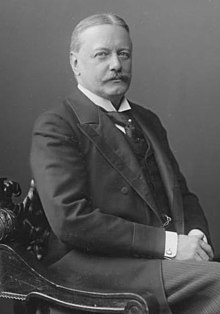Seventh German Inner Africa Research Expedition
The objective was to restore communications with the German legation at Addis Ababa; persuade Ethiopian Emperor Lij Iyasu to support the Central Powers in the First World War and to proceed to Anglo-Egyptian Sudan to provoke an uprising there.
After travelling by rail, cart, camel and dhow to Al Qunfudhah in Saudi Arabia, the party boarded a sambuk for the Red Sea crossing to Eritrea.
The Ethiopian government lent their support to rebels in Entente Somaliland and burnt down several Italian radio stations, but was ousted in a British-supported coup in 1916.
Frobenius continued his scientific expeditions to Africa after the war, but found it difficult to gain entry to British-controlled territories due to his involvement in this operation.
[2] His work in the field is of considerable documentary value but his conclusions on the development of African civilisation from non-African origins were controversial and are not supported by modern writers.
[1] Oberste Heeresleitung, the German high command, were keen to secure the entry of Ethiopia into the war on the side of the Central Powers.
[7] The Germans were hopeful that Ethiopian Emperor Lij Iyasu could be persuaded to ally with Mohammed Abdullah Hassan, a nationalist and religious leader who had fought the colonial authorities in the Somalilands since 1899.
[7] The European members were Frobenius, ethnographer Albrecht Martius, photographer Robert Türstig, foreign office official Hieronymus Kistenfeger and interpreter Mario Passarge.
[7] Amongst the other members was Bekir Sami Kunduh, the former governor of Libya and a future Turkish foreign minister and Friedrich Salomon Hall, a German citizen of Ethiopian origin.
[7][8] The expedition left Berlin in early October 1914 and travelled via Austria, Romania and Bulgaria to reach Constantinople, capital of the Ottoman Empire, on 21 November.
They left the city on 24 December and travelled via the Chemins de fer Ottomans d'Anatolie, the Berlin–Baghdad railway, horse-drawn cart and camel via Aleppo to Damascus, Syria which they reached on 5 January.
Frobenius made careful assessments of the political condition of the regions he travelled through and reported to Berlin of the weakness of Ottoman forces in the area, the unpopularity of their Tripoli-born officials and the poverty and hunger caused by the British blockade and disruption of the Hajj pilgrimage.
[7] The sambuk was intercepted on its first day of travel by the armed merchant cruiser Empress of Russia at the Farasan Islands; because of which Frobenius suspected that his movements in Arabia had been monitored by British agents.
[7] The crew of the sambuk distracted the French sailors by trying to sell postcards to them whilst Frobenius' men used a toilet to enter the boat's sanitary tank.
Frobenius also made contact with Bernhard von Bülow of the Foreign Office in Berlin to obtain diplomatic bags to carry mail to the German Legation in Addis Ababa.
Türstig accompanied the expedition's equipment and the remaining ℳ 2,250.50 back to Germany via Genoa whilst the rest of the members travelled to Rome to meet with Bülow.
[7][12] Frobenius' indiscretion caused the German embassy some difficulties and he was sent back to Germany on 9 April, crossing the Austrian border shortly before Italy declared its intention to enter the war on the Allied side.
[7] In Berlin Frobenius presented the mission as a success, claiming to have made important contacts in the area and was awarded the Iron Cross 2nd Class.
Hall managed to get documents passed to the German legation, which promised the Ethiopians a port on the Red Sea and any territory captured from the Allies in return for their cooperation.
Emperor Iyasu sent weapons to Hassan and destroyed Italian radio stations but was deposed in 1916 after his excommunication by the Ethiopian Orthodox Church, which feared he had converted to Islam.







